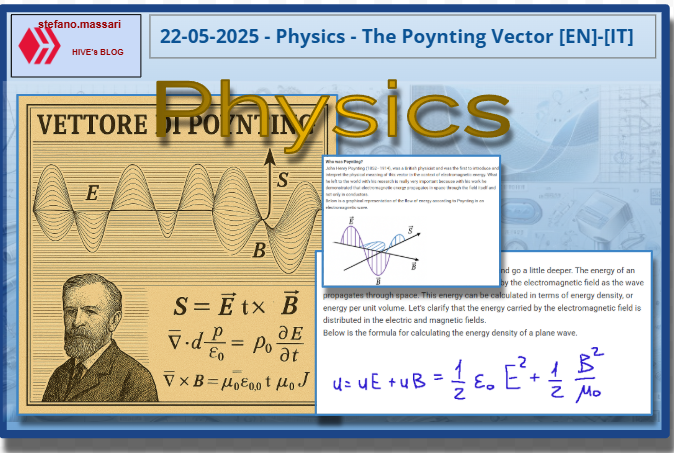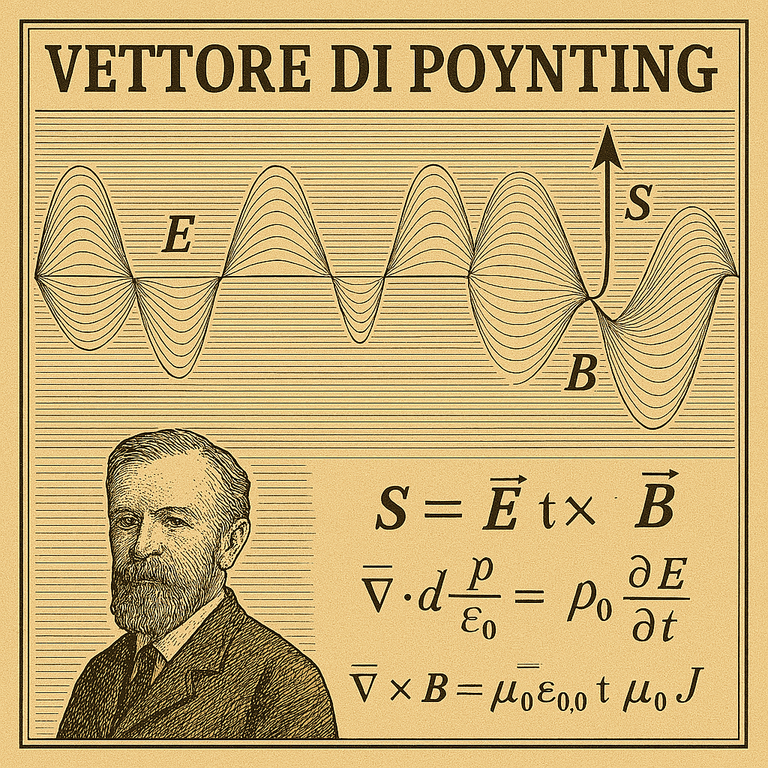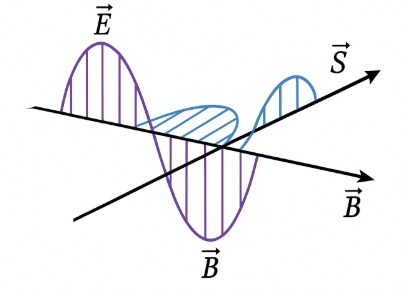
~~~ La versione in italiano inizia subito dopo la versione in inglese ~~~
ENGLISH

22-05-2025 - Physics - The Poynting Vector [EN]-[IT]
With this post I would like to give a short instruction about the topic mentioned in the subject
(code notes: X_16)
The Poynting Vector

image created with artificial intelligence, the software used is Microsoft Copilot
The Poynting Vector and Energy
This name is probably not very popular. Yet the Poynting Vector is a fundamental concept of electromagnetism. This vector describes the flow of electromagnetic energy in space, that is, it indicates the direction and intensity of the energy transport by an electromagnetic field. The Poynting vector is usually identified by the letter S and points in the direction in which the electromagnetic energy propagates.
The formula for the Poynting vector is quite simple, and is represented below.

Where:
E = electric field
B = magnetic field
x = represents the vector product
More descriptively, we can say that this vector shows the energy flow associated with an electromagnetic wave and allows us to calculate the power transported in an electromagnetic system. It is used to analyze the energy radiated by antennas or light sources.
Knowing this vector is important when carrying out studies on electromagnetic radiation, when analyzing the energy transmitted in high-frequency circuits, and when designing antennas and signal transmission.
Who was Poynting?
John Henry Poynting (1852–1914), was a British physicist and was the first to introduce and interpret the physical meaning of this vector in the context of electromagnetic energy. What he left to the world with his research is really very important because with his work he demonstrated that electromagnetic energy propagates in space through the field itself and not only in conductors.
Below is a graphical representation of the flow of energy according to Poynting in an electromagnetic wave.

graph created with AI, ChatGPT
Energy of a plane wave
Now it's time to introduce the concept of energy and go a little deeper. The energy of an electromagnetic plane wave is the energy carried by the electromagnetic field as the wave propagates through space. This energy can be calculated in terms of energy density, or energy per unit volume. Let's clarify that the energy carried by the electromagnetic field is distributed in the electric and magnetic fields.
Below is the formula for calculating the energy density of a plane wave.

Where:
u = total energy density (J/m³)
E = electric field strength
B = magnetic field strength
ε0 = vacuum dielectric constant
μ0 = vacuum magnetic permeability
Power of the electromagnetic wave
The concept of power in electrical circuits takes on a form that is not that complicated. In electrical circuits powered by direct current, calculating power is very simple, while it becomes slightly more complicated when we calculate power on circuits powered by alternating current because we need to know the phase shift factor. Things get a little more complicated when we try to calculate the power of an electromagnetic wave. But what is the power of an electromagnetic wave?
It represents how much energy the wave transfers per second through a surface.
To calculate it, we would need the Poynting vector. Below is the formula for calculating the power of an electromagnetic wave.

Where:
S = the Poynting vector
dA = surface area
S dA = energy flow through that surface
Conclusions
The Poynting vector helps us understand how electromagnetic energy moves and distributes itself in space, so we can understand how it is fundamental to modern science and technology today.
Question
Before Poynting, many thought that energy only moved in wires. Did you know that in 1884, Poynting was the first to realize that energy not only flows in conductors, but also through the field itself, wherever it exists, even in a vacuum?
Did you know that the fact that energy travels in the field, even far from conductors, enables phenomena such as radio waves and wireless transmission?

ITALIAN

22-05-2025 - Fisica - Il vettore Poynting [EN]-[IT]
Con questo post vorrei dare una breve istruzione a riguardo dell’argomento citato in oggetto
(code notes: X_16)
Il vettore Poynting

immagine creata con l’intelligenza artificiale, il software usato è Microsoft Copilot
Il vettore Poynting e l’energia
Questo nome probabilmente non è molto popolare. Eppure il vettore di Poynting è un concetto fondamentale dell’elettromagnetismo. Questo vettore descrive il flusso di energia elettromagnetica nello spazio, cioè indica la direzione e l’intensità del trasporto di energia da un campo elettromagnetico. Il vettore di Poynting solitamente si identifica con la lettera S e punta nella direzione in cui l'energia elettromagnetica si propaga.
La formula del vettore di Poynting risulta abbastanza semplice, ed è rappresentata qui sotto.

Dove:
E = campo elettrico
B = campo magnetico
x = rappresenta il prodotto vettoriale
In maniera più descrittiva possiamo dire che questo vettore mostra il flusso di energia associato a un’onda elettromagnetica e permette di calcolare la potenza trasportata in un sistema elettromagnetico.esso è usato per analizzare l’energia irradiata da antenne o sorgenti luminose.
Conoscere questo vettore è importante quando si effettuano studi sulla radiazione elettromagnetica, quando si fanno analisi dell’energia trasmessa nei circuiti di alta frequenza e quando si progettano antenne e trasmissione di segnali.
Chi era Poynting?
John Henry Poynting (1852–1914), era un fisico britannico e fu il primo ad introdurre ed interpretare il significato fisico di questo vettore nel contesto dell’energia elettromagnetica. Quello che ha lasciato con le sue ricerche al mondo è davvero molto importante perché con il suo lavoro dimostrò che l’energia elettromagnetica si propaga nello spazio attraverso il campo stesso e non solo nei conduttori.
Qui di seguito è mostrato graficamente il flusso dell’energia secondo Poynting in un’onda elettromagnetica.

grafico creato con AI, ChatGPT
Energia di un'onda piana
Ora è il momento di introdurre il concetto di energia ed andarci un po’ più a fondo. L’energia di un’onda piana elettromagnetica è l’energia trasportata dal campo elettromagnetico mentre l’onda si propaga nello spazio. Questa energia può essere calcolata in termini di densità di energia, ovvero in energia per unità di volume. Precisiamo che l’energia trasportata dal campo elettromagnetico è distribuita nei campi elettrici e magnetici.
Qui di seguito, la formula per calcolare la densità di energia di un’onda piana.

Dove:
u = densità di energia totale (J/m³)
E = modulo del campo elettrico
B = modulo del campo magnetico
ε0 = costante dielettrica del vuoto
μ0 = permeabilità magnetica del vuoto
Potenza dell’onda elettromagnetica
Il concetto di potenza nei circuiti elettrici volendo assume una forma che non è poi tanto complicata. Nei circuiti elettrici alimentati a corrente continua, il calcolo della potenza è molto semplice, mentre si complica leggermente quando andiamo a calcolare la potenza sui circuiti alimentati a corrente alternata perché dobbiamo conoscere il fattore di sfasamento. Le cose invece si complicano un pochino quando proviamo a calcolare la potenza di un’onda elettromagnetica. Ma che cos’è la potenza di un’onda elettromagnetica?
Essa rappresenta quanta energia l’onda trasferisce al secondo attraverso una superficie.
Per calcolarla, avremmo bisogno proprio del vettore di Poynting. Qui di seguito è descritta la formula per calcolare la potenza di un’onda elettromagnetica.

Dove:
S = il vettore di Poynting
dA = superficie
S dA = flusso di energia attraverso quella superficie
Conclusioni
Il vettore di Poynting ci aiuta a comprendere come l’energia elettromagnetica si muove e si distribuisce nello spazio, possiamo quindi comprendere come esso sia oggi fondamentale per la scienza e la tecnologia moderna.
Domanda
Prima di Poynting, molti pensavano che l’energia si muovesse solo nei fili. Lo sapevate che nel 1884, Poynting, intuì per primo che l’energia non scorre solo nei conduttori, ma anche attraverso il campo stesso, ovunque esso esista, anche nel vuoto?
Lo sapevate che il fatto che l’energia viaggia nel campo, anche lontano dai conduttori, consente fenomeni come le onde radio e la trasmissione wireless?
THE END

